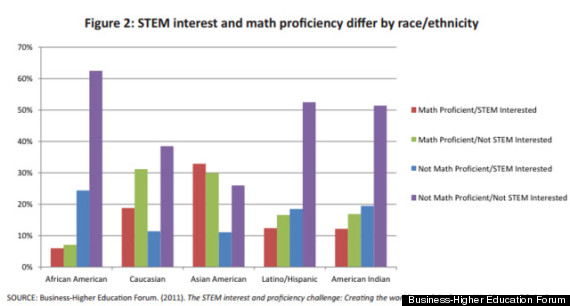As a first year teacher a parent accused me of favoring girls over boys in my earth science course. In my defense, I explained I was working with boys and girls equally (50/50) and that perhaps this was the first time her son had experienced equity.
STEM equity continues to elude educators. Often assessed in terms of undergraduate degrees awarded to women and traditionally underrepresented populations -- STEM equity (outside the life, medical and social sciences) remains a source of concern and frustration for many. Over twenty years of extensive research, by authors such as Seymour, Tobias and Carnevale articulates the nations' shortsightedness in addressing the challenge resulting in an inability to engage and retain women and minorities in many STEM undergraduate programs. If years of research have illuminated the problem, why do we continue to lack equity in STEM education?
"There is no silver bullet".
Courtney Reed-Jenkins (NAPE)
Extensive and disparate barriers complicate efforts to remediate the lack of diversity in STEM. According to research by National Alliance for Partnerships in Equity (NAPE) root causes that inhibit students from pursuing "nontraditional career preparation", such as women becoming physicists or men becoming cosmetologists, fall into domains such as education, career information, family, the individual and society. Within these domains, root causes range from (lack of) early intervention to self-efficacy and from media messages to family characteristics. All communities suffer from multiple impediments varying in degree and nature suggesting the need to identify local causes and develop unique solutions to address STEM equity and diversity.

Recently, I've had the opportunity to participate and work with local and national leaders to promote efforts that lead to STEM equity and diversity. At a regional meeting, the Colorado Community College System (CCCS) in collaboration with the National Alliance for Partnerships in Equity introduced the STEM Equity Pipeline -- an effort to use collaborative impact to ensure equity in state and local STEM education efforts. In this collaboration, NAPE and CCCS elected to work closely with the states' Career and Technical Education (CTE) community. The kickoff meeting and workshop identified the need for a) collecting data b) identifying and selecting strong "champions" for equity in STEM and c) creating a central database of STEM resources.
If NAPE's STEM Equity Pipeline represents a national effort, the work of the Latin American Center for Arts, Science and Education (CLACE) defines grassroots change. Each week for a semester CLACE runs afterschool programs in STEM education at schools that cater to the education of traditionally underrepresented populations. CLACE runs two signature programs: Video and Green Labs. Video Lab seeks to engage middle and high school age students in investigations and story telling around climate change. Students work with videographers and scientists to learn about and articulate their understanding of climate change through bilingual media products. Green Labs, designed for K-5, provides students the opportunity to study earth system sciences using simple, inquiry-based activities and art. CLACE selects facilitators for its afterschool programs from within the local community, seeking individuals who model academic and professional success in their fields of expertise. By drawing upon leadership from within the community CLACE provides students of traditionally underrepresented populations the opportunity to redefine their understanding of opportunity and success post-secondary school.
NSTA Position Statement Learning Science in Informal Environments:
Recent reports emphasize the important role of learning science in informal environments and provide clear evidence that these experiences can promote science learning and strengthen and enrich school science.
The NAPE/CCCS collaboration will address STEM equity issues within the formal education environment (schools) whereas CLACE takes aim at equity through informal education programming. According to researchers Lisa Hope Schwartz and Kathleen Hinko (University of Colorado, Boulder) informal education environments often succeed where formal environments do not because constraints on learning and teaching are very different. Both post-docs work with and study the impact of informal education programs on student perceptions of STEM education and careers. They explain that informal environments included or even emphasized opportunities for youth to explore STEM concepts in open-ended ways not easily supported in schools where constraints include standards, testing and deeply embedded stereotypes about student-teacher roles and relationships. In addition, according to Schwartz and Hinko, "identity development" comes to the fore in informal environments. Recall that NAPE research finds that one important barrier to STEM equity is "individual or internal." In addition, research supports the value of exposing students to informal STEM education opportunities.
What does the Future Hold?

In February of 2013 faculty at the University of Colorado, Boulder received funding from the National Science Foundation to revisit the work of Seymour. The project dubbed, Talking About Leaving Revisited, plans to expand understanding about why capable individuals, especially traditional underrepresented students, elect to pursue non-STEM degree programs. In addition to updating data on undergraduate decision-making about STEM, researchers will examine contributing factors such as the classroom environment and instructional strategies. Will more research improve our ability to engage students in STEM education and careers or motivate educators to improve their instructional practices? As the NAPE research suggests root causes of this persistent issue lie in many domains. While educators continue to do their part to improve the K-16 STEM learning and teaching environment, our efforts may be out-weighed by inaction or counter-productive conditions in other domains.
An abbreviated version of this post originally appeared in SmartBlog-Education, May 28, 2013.
For sources, citations and more, please visit, Haller STEM Education Consulting.